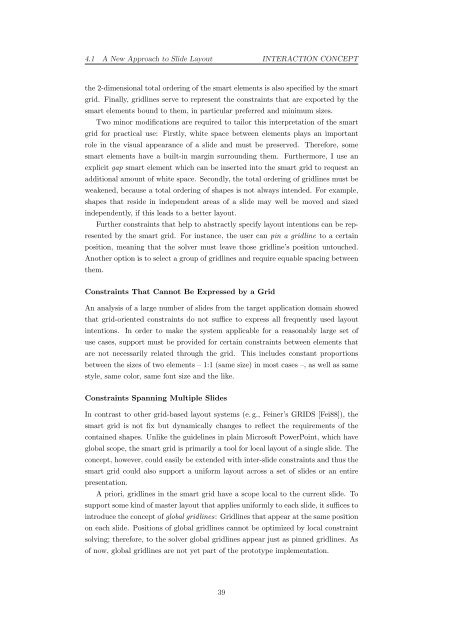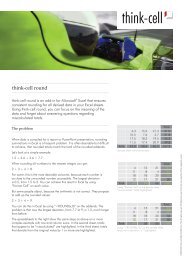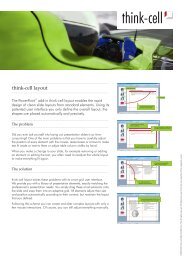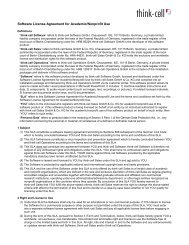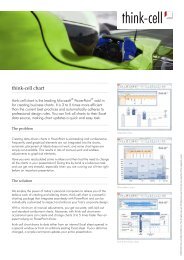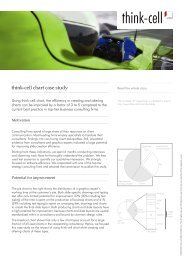think-cell technical report TC2003/01 A GUI-based Interaction ...
think-cell technical report TC2003/01 A GUI-based Interaction ...
think-cell technical report TC2003/01 A GUI-based Interaction ...
You also want an ePaper? Increase the reach of your titles
YUMPU automatically turns print PDFs into web optimized ePapers that Google loves.
4.1 A New Approach to Slide Layout INTERACTION CONCEPT<br />
the 2-dimensional total ordering of the smart elements is also specified by the smart<br />
grid. Finally, gridlines serve to represent the constraints that are exported by the<br />
smart elements bound to them, in particular preferred and minimum sizes.<br />
Two minor modifications are required to tailor this interpretation of the smart<br />
grid for practical use: Firstly, white space between elements plays an important<br />
role in the visual appearance of a slide and must be preserved. Therefore, some<br />
smart elements have a built-in margin surrounding them. Furthermore, I use an<br />
explicit gap smart element which can be inserted into the smart grid to request an<br />
additional amount of white space. Secondly, the total ordering of gridlines must be<br />
weakened, because a total ordering of shapes is not always intended. For example,<br />
shapes that reside in independent areas of a slide may well be moved and sized<br />
independently, if this leads to a better layout.<br />
Further constraints that help to abstractly specify layout intentions can be rep-<br />
resented by the smart grid. For instance, the user can pin a gridline to a certain<br />
position, meaning that the solver must leave those gridline’s position untouched.<br />
Another option is to select a group of gridlines and require equable spacing between<br />
them.<br />
Constraints That Cannot Be Expressed by a Grid<br />
An analysis of a large number of slides from the target application domain showed<br />
that grid-oriented constraints do not suffice to express all frequently used layout<br />
intentions. In order to make the system applicable for a reasonably large set of<br />
use cases, support must be provided for certain constraints between elements that<br />
are not necessarily related through the grid. This includes constant proportions<br />
between the sizes of two elements – 1:1 (same size) in most cases –, as well as same<br />
style, same color, same font size and the like.<br />
Constraints Spanning Multiple Slides<br />
In contrast to other grid-<strong>based</strong> layout systems (e. g., Feiner’s GRIDS [Fei88]), the<br />
smart grid is not fix but dynamically changes to reflect the requirements of the<br />
contained shapes. Unlike the guidelines in plain Microsoft PowerPoint, which have<br />
global scope, the smart grid is primarily a tool for local layout of a single slide. The<br />
concept, however, could easily be extended with inter-slide constraints and thus the<br />
smart grid could also support a uniform layout across a set of slides or an entire<br />
presentation.<br />
A priori, gridlines in the smart grid have a scope local to the current slide. To<br />
support some kind of master layout that applies uniformly to each slide, it suffices to<br />
introduce the concept of global gridlines: Gridlines that appear at the same position<br />
on each slide. Positions of global gridlines cannot be optimized by local constraint<br />
solving; therefore, to the solver global gridlines appear just as pinned gridlines. As<br />
of now, global gridlines are not yet part of the prototype implementation.<br />
39


